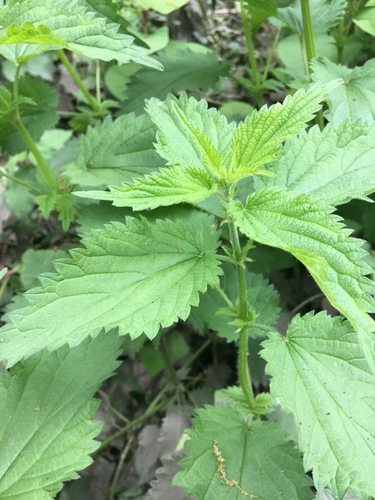Urtica dioica
- Family: Urticaceae
- Common Name: stinging nettle
- Symbol: URDI
- Description: Duration: Perennial Nativity: Non-Native Lifeform: Forb/Herb General: Erect rhizomatous perennial, 0.5-3 m tall, with stinging and non-stinging hairs. Leaves: Opposite, stipulate, the blades elliptic to lanceolate, narrowly to widely ovate or cordate, 5.5-20 cm long, 1.5-13 cm wide, margins coarsely to doubly serrate, apex acute or attenuate, base rounded to cordate, with punctiform mineral concretions known as cystolith in the epidermal cells. Flowers: Paniculate inflorescence, either staminate or pistillate, pedunculate, elongate, the staminate ascending the pistillate lax or recurved; the pistillate flowers with 2 outer tepals linear to slightly spatulate, or lanceolate, 0.8-1.2 mm long, inner 2 tepals ovate to broadly ovate, about 1.5 mm long, a little over 1 mm wide, 4 stamens and a rudimentary, cuplike ovary. Fruits: Ovoid to broadly ovoid, achene just over 1 mm long, less than 1 mm broad, flattened. Ecology: Found in moist soils to 10,000 ft (3048 m); flowers May-August. Notes: The opposite leaves, especially with the acuminate apex and serrate margins, along with the plant being covered in visible stinging hairs helps to identify this species. There are two subspecies: subsp. gracilis and subsp. holosericea. They can be told apart by the former having glabrous to strigose stems, with the undersurface of the leaves being glabrous or puberulous, while the latter has a soft hairy stem, with the undersurface of the leaves tomentose to villous.
Additional Images
- There are no additional images for this species.
